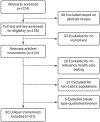Evaluating Patient and Family Experience Among Spanish-Speaking and LatinX Patients: a Scoping Review of Existing Instruments
- PMID: 35913545
- PMCID: PMC10202136
- DOI: 10.1007/s40615-022-01371-x
Evaluating Patient and Family Experience Among Spanish-Speaking and LatinX Patients: a Scoping Review of Existing Instruments
Abstract
Introduction: LatinX populations are rapidly growing in the USA, but still report lower levels of patient centered care and satisfaction when compared to their non-LatinX white counterparts. This review encompasses literature which describes patient experience instruments that (1) evaluate LatinX experience, (2) have validated Spanish versions, or (3) measure language-concordant care experiences.
Methods: A scoping review of literature in Ovid Medline, CINAHL, and PsycINFO was conducted. Articles were excluded if they were not applicable to the health care industry, did not include a patient experience instrument, or did not include LatinX or Spanish-speaking individuals within their study population. Data extraction was performed for concepts measured, study size, population, health care setting, and languages validated.
Results: This review identified 224 manuscripts. Of these, 81 met full inclusion criteria and represented 60 unique instruments. These covered six categories: general patient experience (43%, n = 26/60), experiences of discrimination/mistrust (12%, n = 7/60), cultural factors (10%, n = 6/60), patient-provider relationship (10%, n = 6/60), and communication (8%, n = 5/60). The remaining instruments measured multiple categories (17%, n = 10/60). Just over one third of instruments (n = 24, 5 pediatric, 19 adult) were validated in Spanish and an additional 14 (23%) were validated in English alone. Finally, 4 (7%) instruments were identified which were developed for use in a language concordant setting.
Conclusion: Many instruments were identified which evaluate LatinX patient experience; however, none was both validated in Spanish and measured in all key categories of experience described above. Additionally, few instruments were developed for holistic evaluation of patient experience in pediatric or language concordant care settings.
Keywords: Instruments; Language concordant; Language other than English (LOE); LatinX; Patient experience; Patient satisfaction; Spanish-Speaking.
© 2022. W. Montague Cobb-NMA Health Institute.
Conflict of interest statement
Conflicts of interest/Competing interests:
The authors have no relevant financial or non-financial interests to disclose.
Similar articles
-
Latinx individuals' knowledge of, preferences for, and experiences with prenatal genetic testing: a scoping review.Reprod Health. 2022 Jun 6;19(1):134. doi: 10.1186/s12978-022-01438-2. Reprod Health. 2022. PMID: 35668466 Free PMC article.
-
The Hispanic Clinic for Pediatric Surgery: A model to improve parent-provider communication for Hispanic pediatric surgery patients.J Pediatr Surg. 2016 Apr;51(4):670-4. doi: 10.1016/j.jpedsurg.2015.08.065. Epub 2015 Sep 15. J Pediatr Surg. 2016. PMID: 26474548
-
Latinx Patients' Perceptions of Culturally Sensitive Health Care and their Association with Patient Satisfaction, Patient-Provider Communication, and Therapeutic Alliance.J Racial Ethn Health Disparities. 2022 Apr;9(2):620-629. doi: 10.1007/s40615-021-00994-w. Epub 2021 Mar 15. J Racial Ethn Health Disparities. 2022. PMID: 33721290
-
A qualitative assessment of factors contributing to Spanish-speaking federally qualified health center patients' chronic pain experiences.PLoS One. 2023 May 18;18(5):e0285157. doi: 10.1371/journal.pone.0285157. eCollection 2023. PLoS One. 2023. PMID: 37200248 Free PMC article.
-
Screening Instruments for Developmental and Behavioral Concerns in Pediatric Hispanic Populations in the United States: A Systematic Literature Review.J Dev Behav Pediatr. 2020 Jan;41(1):71-80. doi: 10.1097/DBP.0000000000000724. J Dev Behav Pediatr. 2020. PMID: 31609290
Cited by
-
Psychometric assessment of the US person-centered prenatal and maternity care scales in a low-income predominantly Latinx population in California.BMC Womens Health. 2023 Nov 17;23(1):616. doi: 10.1186/s12905-023-02721-5. BMC Womens Health. 2023. PMID: 37978490 Free PMC article.
References
-
- Flores A How the U.S. Hispanic population is changing ∣ Pew Research Center. Pew Research Center. Published September 18, 2017. Accessed March 14, 2022. https://www.pewresearch.org/fact-tank/2017/09/18/how-the-u-s-hispanic-po...
Publication types
MeSH terms
Grants and funding
LinkOut - more resources
Full Text Sources
Miscellaneous

